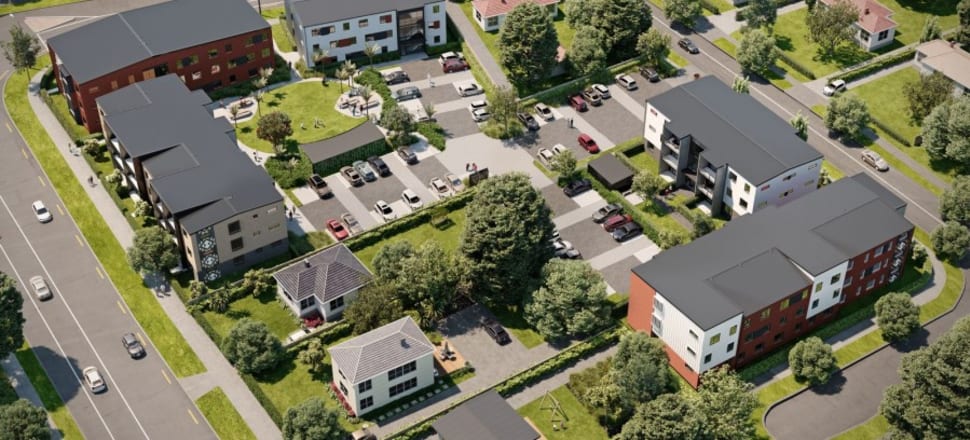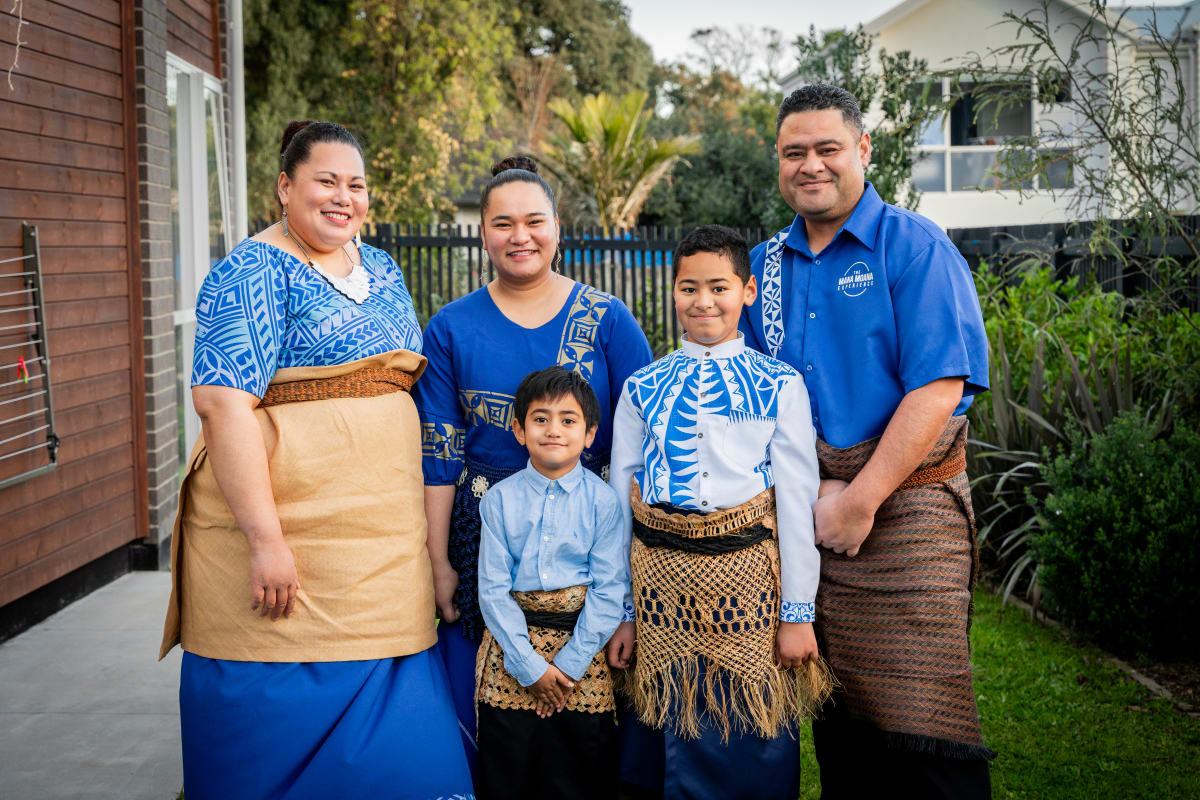
The replacement of old state homes with medium-density villages has changed the face of Tāmaki
Across the road from Tāmaki College and deep in the heart of Glen Innes is an unused meadow with a prime view of Maungarei Mt Wellington.
It has stood empty for decades – once the site of Tamaki Girls College, before boys and girls colleges were combined into one and a fire in 2003 gutted the last of the school’s buildings.
In a city where land values have skyrocketed and lopped the bottom rungs from the property ladder, there’s something odd about nearly five hectares of breathing space within a stone’s throw of the Glen Innes Train Station.
But within a few years, the site at 136 Taniwha could host an entire village, with 158 public and affordable homes planned for construction by a Crown entity taking a new approach to grappling with the housing issue.
Despite previous plans to put a retirement village on the site, Ngāti Whatua Ōrākei sold the land to the government-funded Tāmaki Regeneration Company (TRC) last year.
The organisation is 10 years into rolling out a unique housing programme in East Auckland, where paving the way for people to move from public housing to rental and home ownership is the priority.

The company will replace 2500 old state homes across the suburbs of Glen Innes, Point England and Panmure with 3500 new state homes and 7000 affordable and market homes, while partnering with council and central government to build commensurate infrastructure and revitalise town centres.
Work began in earnest in 2016, when Housing New Zealand handed over ownership and tenancy responsibilities for state homes in the area to TRC.
All it takes is a drive around these suburbs on the banks of the Tāmaki estuary to quickly see the changing face of this part of Auckland.
Medium-density new builds have doubled or tripled the number of homes lining streets formerly the domain of state houses built following World War II.
Mele Havili and her partner Samisoni are proud home-owners in the Point England area.
After coming to New Zealand from Tonga to study, meeting her husband and having two boys, home ownership had still seemed out of her grasp.
“It was one of our dreams and visions to own our own home,” she said. “But every year the goalposts kept moving.”
Havili said the programme helped the couple not only through a more affordable shared ownership model, but also by guiding them through the mortgage application process and helping them manage prior debts.
Now she has a three-bedroom terrace house she can one day leave for her boys.

“It really changes the narrative for them,” she said. “Not only in that it creates a long-term form of wealth, but also it’s our own little patch of the whenua.”
By producing affordable private homes as well as state houses, the organisation hopes to create an accessible pathway for people to go from state home resident to home-owner.
At the moment, that pathway is practically a brick wall, according to TRC chief executive Shelley Katae.
She hoped giving people options would
reduce the amount stuck in a state home cycle.
People who could earn just above the income threshold for public housing have the option of moving up the ladder and spending the lion’s share of a low income on rent.
But when Katae first joined the organisation in 2013, there were lines of protesters outside the door.
Previous housing initiatives had seen 150 state homes knocked down in the area and replaced with just 75, potentially kicking poorer families out of the area.
“In the community's mind it was gentrification happening all over again,” Katae said.
She said many in the community were just a generation or two removed from when areas like Ponsonby or Grey Lynn were affordable for lower-income families. Those families were scattered to the winds by prohibitive property prices.

Katae said her organisation also needed to take responsibility for that previous work, as the community wouldn't necessarily distinguish between different arms of government.
However, she said it taught the organisation a valuable lesson.
“You have to be aligned with community aspiration, or else you are going to fail,” she said. “That's the thing about this community, they have a strong voice. We have a board, but in a way our biggest accountability is with the community.”
She said it was an undertaking requiring “a bit of thick skin”, especially when staff are out in the community interacting with the owners of those strong voices.
“If Aunty Georgie from Ruapōtaka marae has got a problem, I tell you what, I'll get a phone call within about five minutes, because she has my number,” she said.
Strategy and masterplanning general manager Joanna Brain said there’s nothing like being in the community you affect every day.
“There's nothing to hold you to account more than walking down the street and seeing someone who actually is impacted by the decisions you make on a daily basis, and if they come up to you and say thank you so much, that was really helpful for our whānau, you feel amazing,” she said. “But if they come up to you and say that didn't work for us, you've got to do better the next day."
Over the past 10 years, Katae said many of those who were protesting are now on-side.
Development and commercial general manager Dan Henderson said some former protesters were now board representatives of the community.
But it seems there were some rocky times over the past decade, as groups like Tāmaki Housing Action continued to rail against the transferal of state homes and labelled regeneration another word for gentrification.
That group has been quiet since before the pandemic, however.
Opposition to housing changes have often centred around former state homes becoming private dwellings, but Henderson argued easing the transition out of the system would also reduce the need for the number of state homes.
“If you get a family that can transition out of a state home into an affordable [home] over time, you’re freeing up state homes,” he said. “At the moment we seem to have an endless demand, because people are stuck.”
He said adding to the pool of public housing wasn't always an easy proposition – a lot of the time it first required removing state homes that were already there, before the new ones could be built.
Then there’s the emotional connection many have with the state houses they may have been in for generations.
Katae acknowledged it hadn't always been easy bringing a new housing programme into the community, and there had been a few “skinned knees” to learn from.
She said at times there hadn’t been enough of an induction for new members of communities and it had taken some growing pains for the organisation to work out how diverse its service offering should be.
She said one of the pillars of TRC nowadays was making sure people from Tāmaki got to stay in Tāmaki. That can mean first dibs on housing options, or just making sure the community is aware of what changes are coming up.
And in Tāmaki, there are plenty to choose from.
The streets of this patch of Auckland are dotted with new construction and development, not all of it helmed by TRC.
Katae said this was once a thriving part of the city, where trade hubs along the banks of the Tāmaki estuary profited from busy activity as waka travelled to and from the one-kilometre portage at Ōtāhuhu.
It went on to become one of the most densely-packed areas of state housing in the country.
But now as many of those houses near their eighth decade, it seems Tāmaki may have reached yet another crossroads.







